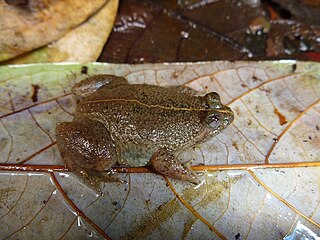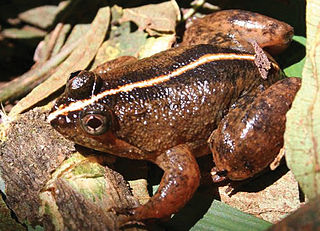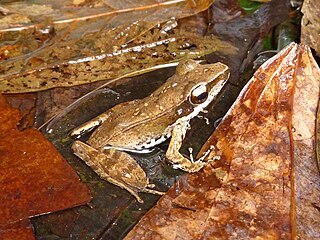
Occidozyga is a genus of frogs in the family Dicroglossidae found in southeastern Asia between eastern India, southern China, and Java. They sometimes go under the common name Java frogs or floating frogs.

Smith's wrinkled frog, commonly known as Tasan eastern frog, Tasan frog, or Tha san frog,) is a species of frog in the family Dicroglossidae. It is found in western and southern Thailand; its range likely extends to Myanmar but it has not yet been recorded there. Its natural habitats are primary rainforests near streams. It is threatened by habitat loss.
Limnonectes arathooni is a species of frog in the family Dicroglossidae. It is endemic to southwestern Sulawesi, Indonesia.

Limnonectes dabanus is a species of frog in the family Dicroglossidae. It is found in Cambodia and Vietnam. Its natural habitats are tropical moist lowland forests, rivers, and swamps. Its status is insufficiently known.
Limnonectes grunniens is a species of frog in the family Dicroglossidae. It is found in Sulawesi, Molucca Islands, and New Guinea. Frogs from Sulawesi may represent a different, undescribed species.
The Malesian frog, Malaysian river frog, Malaysian peat frog, or peat swamp frog is a species of frog in the family Dicroglossidae. It is found on the Malay Peninsula, Sumatra, Java, Borneo, and a range of islands on the Sunda Shelf . Its natural habitats are shallow, gentle streams and nearby swampy areas including peat swamps, very flat alluvial forests, and overgrown plantations. It is becoming rare due to habitat loss (deforestation), and to a lesser extent, exploitation.

Limnonectes paramacrodon is a species of frog in the family Dicroglossidae. It is found in Malay Peninsula, Borneo, and Natuna Besar. Its natural habitats are lowland swamp forest areas with small rivers and streams. It is becoming rare due to habitat loss.

The seep frog or Balu oriental frog, Occidozyga baluensis, is a species of frog in the family Dicroglossidae. It is probably endemic to Borneo.

The Sulawesian puddle frog or Celebes Oriental frog is a species of frog in the family Dicroglossidae. It is endemic to Sulawesi, Indonesia.
The small-headed frog or tiny oriental frog is a species of frog in the family Dicroglossidae. It is endemic to the Philippines where it is found on Mindanao, Basilan, and in the Sulu Archipelago.
Occidozyga floresiana is a species of frog in the family Dicroglossidae. It is endemic to Flores, Indonesia.

The common puddle frog, puddle frog, or yellow bellied puddle frog is a species of frog in the family Dicroglossidae. It has often been confused with Occidozyga sumatrana, and records of this species outside the Philippines likely represent that species.

Occidozyga magnapustulosa is a species of frog in the family Dicroglossidae. It is known from scattered locations in northern and eastern Thailand, and in Laos and Vietnam.

The Sumatran puddle frog is a species of frog in the family Dicroglossidae. It might be endemic to Indonesia. However, it has often been confused with Occidozyga laevis, and was also for long considered to be its junior synonym.
Occidozyga vittata is a species of frog in the family Dicroglossidae. It is endemic to southern and central Vietnam, where it was recorded in Đà Lạt, Lâm Đồng Province and Thừa Thiên-Huế Province.
Djoko Tjahjono Iskandar is an Indonesian herpetologist who studies the amphibians of Southeast Asia and Australasia. He is a professor of biosystematics and ecology at Bandung Institute of Technology in West Java, Indonesia.

The frog family Dicroglossidae occurs in tropical and subtropical regions of Asia and Africa, with most genera and species being found in Asia. The common name of the family is fork-tongued frogs.

Papurana celebensis, also known as the Celebes frog, is a species of true frog in the family Ranidae. Prior to being reclasified into the genus Papurana in 2020, it was referred to as "Hylarana" celebensis. It is endemic to Sulawesi (Celebes), Indonesia. It is a lowland forest species, also occurring disturbed habitats.
Occidozyga tompotika is a species of frog in the family Dicroglossidae. It is endemic to Sulawesi, Indonesia, where it is known from the Balantak Mountains in the Central Sulawesi Province. It is named after Mount Tompotika, its type locality.

Alcalus rajae, sometimes known as king dwarf mountain frog, is a species of frog in the family Ceratobatrachidae, subfamily Alcalinae. It is endemic to Kalimantan, Borneo (Indonesia), and known from its type locality in the Bukit Baka Bukit Raya National Park, as well as the Gunung Penrissen Nature Reserve, both in the West Kalimantan province, and from the Meratus Protected Forest in the South Kalimantan province. The specific name rajae refers to the type locality: Bukit Raya is the highest mountain in Kalimantan, getting its name from the Indonesian word raya, signifying the majestic size of the peak. It also alludes to the relatively large size of this species relative to its (then) congeners.












